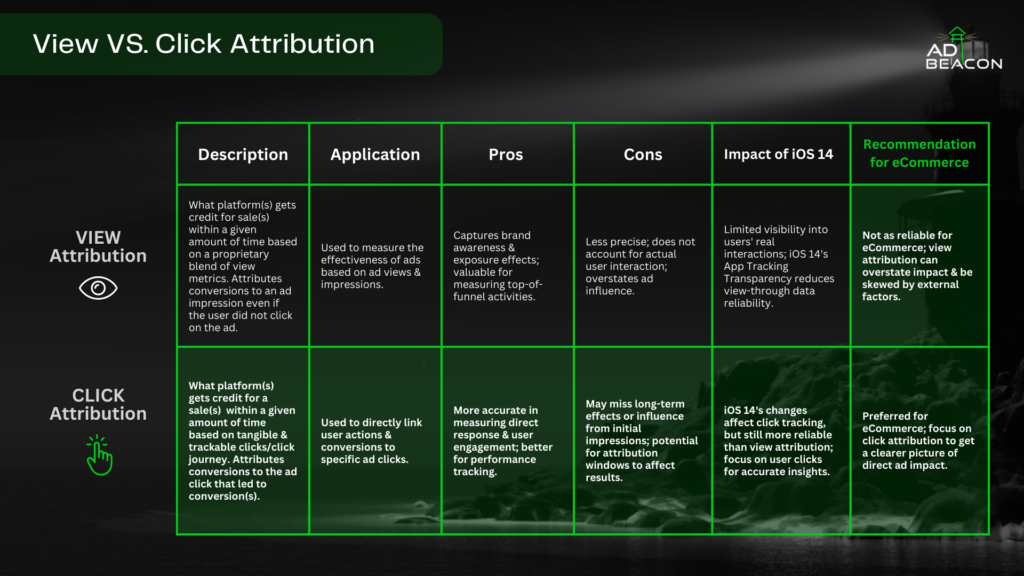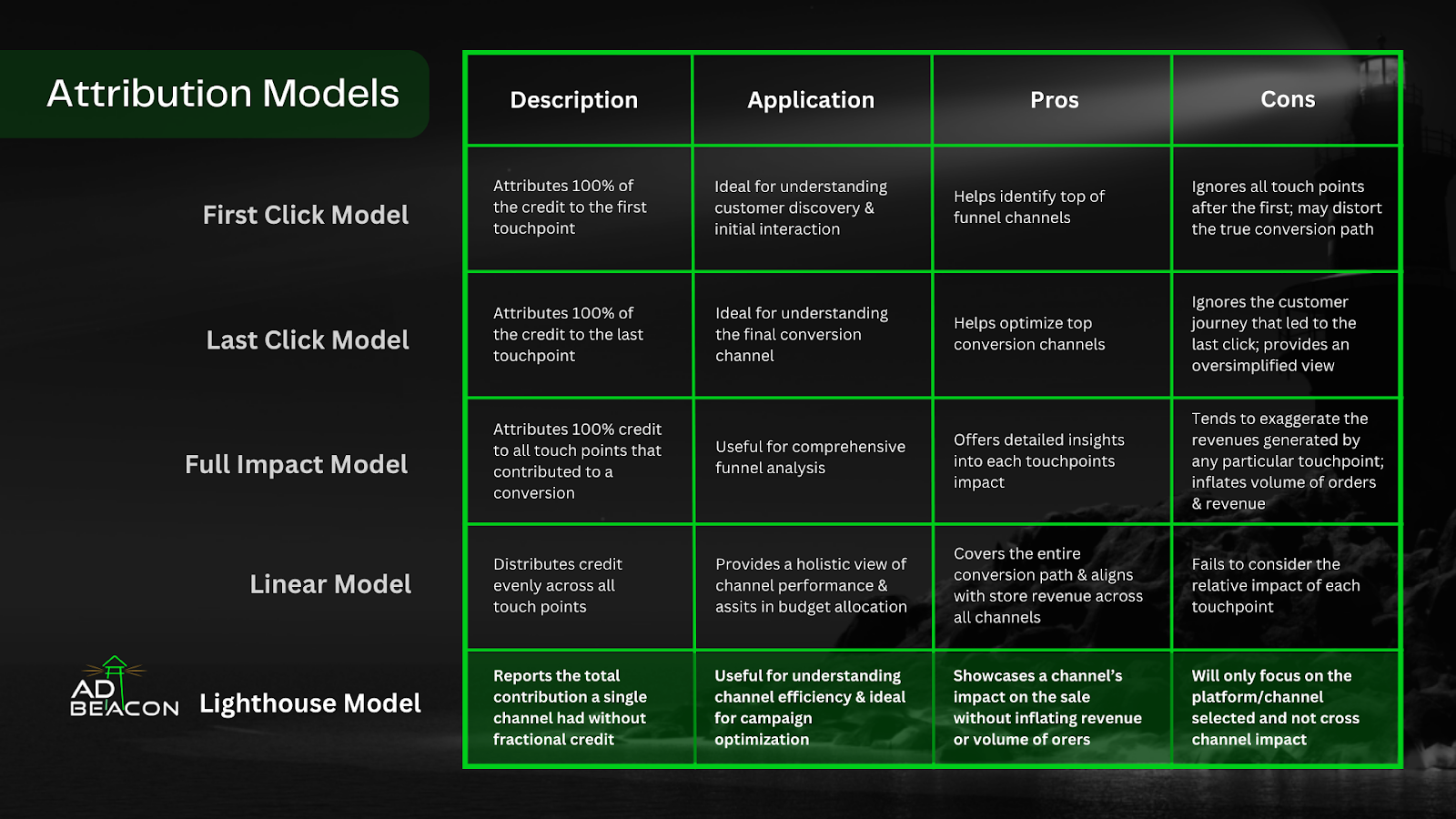Having the right tools to manage and optimize your marketing campaigns is fundamental, and a variety of useful platforms have been developed to fill this ever-present need. AdBeacon is undeniably a leader in the digital marketing space, but we’re hardly the only horse on the track. There are other options as well—including Triple Whale.
Triple Whale provides a suite of tools for tracking metrics, managing ad spend, and enhancing campaign performance across various marketing channels such as Meta, TikTok, and Pinterest. Its features include advanced attribution models that cater to high-level marketing efforts. However, Triple Whale’s complexity and reliance on view attribution can sometimes complicate the decision-making process for media buyers.
This is where AdBeacon shines as a superior alternative. AdBeacon focuses on simplifying the attribution process with a click-only attribution model, ensuring that decisions are made based on tangible, provable data.
By eschewing view attribution, AdBeacon avoids the inconsistencies and inflated metrics that can arise from differing definitions across platforms. This focus on clarity and actionability, combined with features tailored for media buyers and marketing teams, makes AdBeacon the right choice for those looking to enhance their marketing efforts and boosts the overall value of their marketing tech stack.
The Click-Only Attribution Model
Attribution is the cornerstone of understanding the effectiveness of marketing campaigns. It helps marketers track which interactions, or clicks, are leading to conversions, allowing for more informed decision-making.
In the complex landscape of digital marketing, accurately attributing credit to different touchpoints can be challenging. This is where AdBeacon‘s click-only attribution model comes into play—it provides a straightforward and transparent approach to tracking conversions.
What Is Click-Only Attribution?
Click-only attribution, as implemented by AdBeacon, focuses exclusively on interactions where users have clicked on an ad. Unlike models that consider view attribution—which assigns partial credit to ads that were viewed but not clicked—click-only attribution ensures that only tangible actions are counted. This model simplifies the attribution process by eliminating the ambiguity associated with view-based interactions. This approach is beneficial in multiple ways:
- Simplicity and Transparency
- Click-only attribution provides a clear and understandable method for tracking customer interactions. By focusing solely on clicks, it removes the complexity introduced by varying definitions of what constitutes a view.
- Accuracy and Provable Data
- Since a click represents a definitive user action, this model offers more accurate data. It avoids the inflation of metrics that can occur with view attribution, where an ad impression is counted even if the user did not actively engage with the ad. This results in cleaner data that marketers can confidently use to make decisions.
- Eliminating Ambiguity
- Different platforms have different standards for what constitutes a view, leading to potential inconsistencies and confusion. Click-only attribution sidesteps this issue by relying on a universal action: the click. This consistency helps in providing a clearer picture of customer journeys and the effectiveness of marketing efforts.
By focusing on clicks, AdBeacon ensures that only the most relevant interactions are considered, thereby providing a more reliable foundation for evaluating campaign performance.
AdBeacon's Transparency
AdBeacon‘s decision to focus on click-only attribution is all about transparency. There are no proprietary or black-box models—everything is straightforward and explainable.
This transparency is a key differentiator from competitors like Triple Whale, which incorporates more complex models that may include view attribution, which can lead to inflated metrics and less clear data for decision-making.
This approach ensures that every decision is based on reliable data, ultimately enhancing the overall user experience and campaign performance for media buyers and marketing teams.
Our Optimization Attribution Model
AdBeacon‘s optimization attribution model goes beyond traditional attribution by relying on an actionable approach to data analysis.
While the click-only attribution model offers clarity and accuracy, AdBeacon‘s overall attribution framework integrates various tools and features designed to enhance marketing efforts and improve campaign performance in real time.
Understanding AdBeacon's Attribution Model
AdBeacon‘s attribution model is built around a transparent, user-friendly framework that prioritizes actionable insights. Unlike some platforms that use proprietary or black-box models, AdBeacon ensures that every aspect of its attribution process is clear and understandable to users. This transparency is essential for media buyers and marketing teams who need reliable data to make informed decisions.
- Real-Time Data Integration
- AdBeacon integrates first-party data to ensure that marketers have access to the most current information and have the tools to make quick adjustments and optimizations.
- Customizable Attribution Models
- AdBeacon allows users to customize their attribution models based on their specific needs. Whether it’s adjusting the attribution window or focusing on particular metrics, marketers can easily customize the model to fit their strategy. This flexibility is vital for optimizing ad spend and enhancing campaign performance across different channels.
- RFM Analysis and Audience Segmentation
- AdBeacon includes advanced tools for RFM audience analysis, which helps in segmenting audiences based on their purchasing behavior. Thes custom segments integrated into the attribution model to provide deeper insights into the customer experience and allowing for more targeted marketing efforts.
- Creative Dashboard
- The creative dashboard is a key component of AdBeacon‘s optimization model. It offers a comprehensive view of ad performance, helping marketers identify which creatives are driving the most engagement and conversions. By providing detailed metrics and tracking for each ad campaign, the creative dashboard enables media buyers to make data-driven decisions that enhance overall campaign effectiveness.
- Optimization Capabilities
- AdBeacon’s platform is designed with a read and react model, emphasizing the need to act on data insights quickly. This capability is enhanced by the Chrome extension, which overlays AdBeacon data on the Meta ads manager, so users can make real-time decisions based on accurate, first-party data. This feature is particularly beneficial for media buyers who need to adjust their strategies on the fly to maximize ad spend efficiency.
Pricing
AdBeacon’s pricing model is straightforward and cost-effective, designed to never exceed half a percent of monthly tracked revenue. This all-inclusive approach ensures businesses have access to all features without worrying about hidden costs or add-ons. That makes AdBeacon eminently suitable for a wide range of companies from small startups to large enterprises.
In contrast, Triple Whale offers tiered pricing tailored to different business sizes and needs, starting with affordable plans for smaller businesses and scaling up to customized pricing for large enterprises. While Triple Whale’s flexible pricing caters to various scales, AdBeacon’s transparent and predictable costs provide significant value, so we’re a more budget-friendly and comprehensive solution for marketing teams looking to optimize their ad spend and enhance campaign performance.
How Does AdBeacon Measure Up as a Triple Whale Alternative?
When comparing AdBeacon and Triple Whale, several key factors highlight why AdBeacon stands out as a superior option for media buyers and marketing teams.
Let’s break down the differences and advantages across various categories to demonstrate AdBeacon‘s superiority.
Tracking and Attribution
- AdBeacon: Utilizes a click-only attribution model, ensuring transparency and reliability by focusing solely on provable clicks. This avoids the complications and inflated metrics associated with view attribution. Furthermore, AdBeacon uses UTMs to accurately track the effectiveness of marketing campaigns.
- Triple Whale: Incorporates more complex attribution models, including view attribution, which can lead to inconsistencies and inflated metrics due to varying definitions across platforms like Meta, Google Ads, TikTok, and Pinterest.
Real-Time Data and Optimization
- AdBeacon: Emphasizes real-time data integration, allowing media buyers to make immediate adjustments to their campaigns. The platform’s real-time capabilities are enhanced by tools like the Chrome extension, which overlays data on the Meta ads manager for quick, confident decision-making.
- Triple Whale: Offers real-time data but focuses more on centralized analytics and comprehensive reporting, which might not provide the same level of immediate actionability as AdBeacon.
Customization and User Experience
- AdBeacon: Provides customizable attribution models and tools tailored for media buyers, including RFM analysis and audience segmentation. The creative dashboard offers detailed insights and actionable data, making it easier to optimize campaigns effectively.
- Triple Whale: Also offers customization options and advanced analytics, but its complexity can sometimes be overwhelming for users seeking straightforward, actionable insights.
Pricing and Value
- AdBeacon: Features an all-inclusive pricing model that caps at half a percent of monthly tracked revenue, ensuring predictability and cost-effectiveness. This model includes all features with no hidden costs or add-ons.
- Triple Whale: Uses a tiered pricing structure that scales with the business size and needs, potentially leading to higher costs for access to advanced features. While flexible, it may not offer the same level of value and predictability as AdBeacon.
Support for Media Buyers
- AdBeacon: Designed by media buyers for media buyers, the platform offers tools and reports specifically crafted to meet their needs. This focus ensures that the user experience is intuitive and aligned with the daily operations and challenges of media buying teams.
- Triple Whale: Provides extensive features and support, but its broader focus on ecommerce may not adequately complement the nuanced needs of media buyers and advanced marketing teams.
Learn More About AdBeacon
We invite you to experience the benefits of AdBeacon firsthand by contacting us for a free personalized demo. Let us show you how AdBeacon can enhance your marketing efforts and help you maintain a healthy tech stack.

